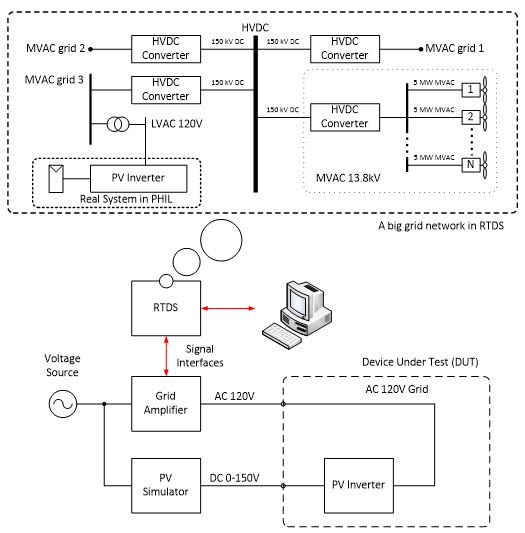
The Power hardware in the loop (PHIL) studies consists of a Power source being interfaced with the Real Time Digital Simulator (RTDS). The loop acts as an interface to exchange power between the system emulated in RSCAD environment with the actual device. The Stability issues in PHIL has always been of major concern due to the inherent delays within the interface devices. The program is to determine methodologies to achieve stable performance of PHIL while connecting to a Power electronics system to RTDS.
The technology of Power Hardware in the Loop (PHIL) is gaining interest in recent years in industries as well as in academic research settings. The PHIL arrangement offers a variety of advantages in terms of flexibility, space requirement and time. This semi-physical simulation setup can emulate an actual-like environment to evaluate real power apparatuses. This type of testing platform provides a great degree of freedom while evaluating renewable-sourced Power Electronic (PE) converters. One of the applications is, testing a Photovoltaic (PV) inverter connected to the grid under changing environmental conditions and performing various other grid interaction studies. RIGA Lab extends the existing studies in PHIL and develops a mathematical framework for quantifying the stability criteria. Further, a comprehensive analysis of the stability problem including verification of theory and mathematical analysis through experiments for PV inverter evaluation. In addition, a methodical approach to work with stable PHIL is also developed.
Suggested Reading - M. Pokharel, and C. Ho, “Stability Analysis of Power Hardware in the Loop (PHIL) Architecture with Solar Inverter”, IEEE Trans. on Industrial Electronics, vol. 68, no. 5, pp. 4309-4319, May 2021. (PDF)
Electric vehicles (EVs) have become increasingly popular and mature in terms of their technology, and accordingly, their rapid growth is expected to persist in the coming decades. Subsequently, EV charging is on the verge of becoming a commodity. Among residential communities, the use of onboard EV chargers has become a preferable choice simply for its ability to connect to a single-phase residential plug with functions of grid-to-vehicle (G2V) and vehicle-to-grid (V2G) operations. Extensive addition of EV chargers into the low-voltage (LV) grid may create power quality (PQ) issues and alternatively, EV chargers could also be affected by PQ issues originated elsewhere. These scenarios have urged to conduct studies for evaluating PQ issues in the LV grid as well as to develop advanced EV chargers. The PHIL simulation can be described as a hybrid technique that decouples the original circuit using a power interface as such, a part of the circuit is being simulated inside the real time simulator (RTS), and the rest of the circuit is completed with an actual device under test (DUT). The hybrid nature of PHIL simulations makes it well-suited for evaluating grid-connected EV chargers. It allows to test and validate both the physical EV charger and the LV grid it operates with several attractive features such as reduced cost, less time, scalability, repeatability, flexibility and perhaps most importantly with low-risk testing. RIGA Lab are developing a PHIL platform to evaluate EV chargers using switched-mode amplifiers. That can effectively reduce R&D cost of developing EV chargers.
Suggested Reading - I. Jayawardana, C. Ho, and Y Zhang, “A Comprehensive Study and Validation of a Power-HIL Testbed for Evaluating Grid-Connected EV Chargers”, IEEE Journal of Emerging and Selected Topics in Power Electronics, vol. 10, no. 2, pp. 2395-2410, April 2022. (PDF)
Field testing using real PV arrays is expensive, bulky and time consuming. Moreover, output current-voltage (I-V) characteristics of a PV cell depends on environmental conditions like, solar irradiation level and atmospheric temperature. Hence, it is not feasible to maintain a controllable testing environment. To overcome these problems, PV emulators (PVEs) are used in test setups and now it has become an essential device among power and energy researchers as a tool to evaluate different contingency test scenarios, especially aviation and space applications. Switched-Mode-Power-Supply (SMPS) have been extensively used in the literature for PVEs, however, their performance are not promising in terms of response time and limited bandwidth compared to linear power stage schemes. It can not truely simulate real PV modules, whcih exhibit fast dynamic response and have proven to reach the steady-state within few microseconds to tens of microseconds after a transient. RIGA Lab are developing a fast-convergent reference generation algorithm (RGA) using load resistance feedback to make it independent from inner control loop design and for achieving a stable reference signal over entire I-V curve. Additionally, the controller utilizes a wide bandwidth inner control loop to improve dynamic response of the PVE for keeping its usefulness in testing real applications such as MPP tracking (MPPT) converters which have a convergence speed of tens of milliseconds
Suggested Reading - I. Jayawardana, C. Ho, M. Pokharel, and G. Escobar’ “A Fast-Dynamic Control Scheme for a Power-Electronics-Based PV Emulator,” IEEE Journal of Photovoltaics. vol. 11, no. 2, pp. 485-495, March 2021. (PDF)